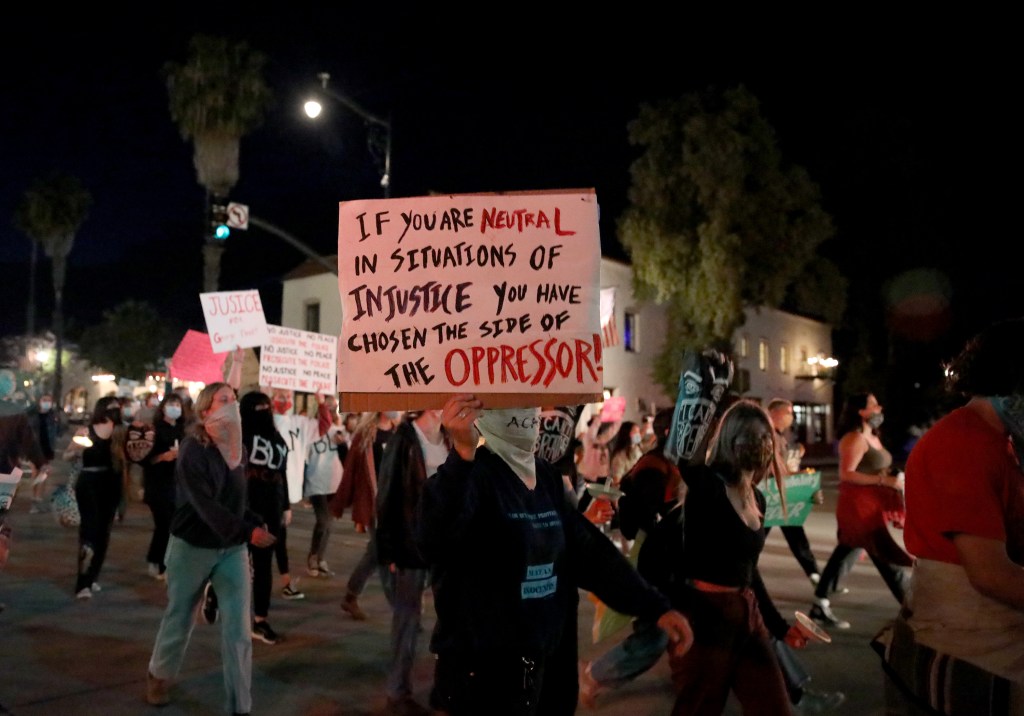If you weren’t mad, it used to be said, partially in jest, you must not be paying attention. These days, it’s no longer a joke.
This past week was lightyears beyond rough. Lost in all the din, the United States quietly exceeded 100,000 COVID-related deaths and 40 million first-time unemployment applications. What kind of a din can drown out numbers like that?
Turns out the death of a guy named George Floyd and the Minneapolis cops who killed him almost a week ago. Floyd’s murder highlights — yet again — the extent to which we’re still rowing in very different boats, even if we’re all floundering together in the same hot water. Among Floyd’s last words were, “I can’t breathe.”
The same could have been said by all 100,000 of the country’s COVID victims, though for obviously very different reasons. But Floyd, so far as anyone knows, never tested positive for the virus. He died of an overdose of a white knee pressed against his black neck, applied by a cop with a history of 18 citizen complaints, for nearly nine excruciating minutes. Try counting slowly to 540. That’s how long it took. And for most of the last three minutes Floyd had already passed out.
He was not resisting. He never did. And he was handcuffed.
Floyd and the cop — since charged with third degree murder and manslaughter — worked together as bouncers for the same night club it turns out. There’s no indication the two knew each other. The cop was white. He had a reputation for being especially aggressive when dealing with patrons of color. It was known.
Floyd had moved from Houston to Minneapolis — an NPR tote bag kind of town where Garrison Keillor’s Prairie Home Companion originated — to turn his life around. By all reckoning, he appeared to have done so. The cops who pulled him over suspected he might have passed a bogus $20 bill. Floyd happened to be 6’ 7”. And, of course, black.
No doubt when the autopsy is finished, it will conclude Floyd’s cause of death to be something other than strangulation and asphyxiation. As often happens in such cases, it could well be chalked up to a pre-existing condition. Being a black man in the United States qualifies as a pre-existing condition. So, too, we have just been reminded, is jogging — or even bird-watching — while black.
Or perhaps just being born. Floyd was born in 1974, 10 years after LBJ signed the historic Civil Rights Act of 1964, 110 years after slavery was abolished, and 24 years before Barack Obama would be elected president. Even with all that progress, black people still have the highest infant mortality stats in the United States and the lowest life expectancies. And most of the other metrics between cradle to grave — medical, educational, and income — flat out suck, too. Like being shot by cops.
It’s worth noting that Santa Barbara’s Chief of Police Lori Luhnow issued a statement saying she was “deeply disturbed by Mr. Floyd’s death,” adding that it was “preventable and should not have happened.” Law enforcement, she added, has contributed to the “marginalization of many disadvantaged groups, including African Americans.” Law enforcement officers, she added, are responsible for making sure that does not happen. Cops, Luhnow said, have a “duty to intervene” when other cops act “outside the law.” It was, she said, “our policy and our moral obligation.”
Luhnow is the first woman to serve as Santa Barbara’s police chief. She may know a thing or two about crashing up against the glass ceiling. “Ground glass,” coincidentally, is the phrase commonly used to describe what happens to the lungs of patients with advanced COVID.
At a time when the president has escalated the racist content of his rhetoric from dog whistle to wolf whistle, Luhnow’s remarks are especially welcome.
Mental health professionals often counsel that rage is grief all dressed up with no place to go. Well, we’ve got a ton of grief to deal with. How the hell can anyone breathe?
There will be an action held at Santa Barbara’s downtown courthouse in response to the George Floyd killing on Sunday, May 31, at 1 pm.

